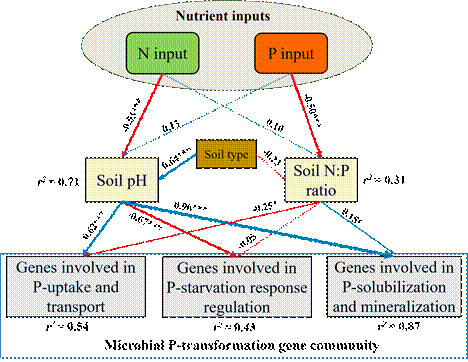The ISME Journal:Long-term nutrient inputs shift soil microbial functional profiles of phosphorus cycling in diverse agro-ecosystems
2020-01-13
Research Team Led by Prof. Xu Jianming published its latest research findings titled “Long-term nutrient inputs shift soil microbial functional profiles of phosphorus cycling in diverse agro-ecosystems” in The ISME Journal by the Nature Publishing Group on December 11, 2019.
Microorganisms play an important role in soil phosphorus (P) cycling and regulation of P availability in agroecosystems. However, the responses of the functional and ecological traits of P-transformation microorganisms to long-term nutrient inputs are largely unknown. This study used metagenomics to investigate changes in the relative abundance of microbial P-transformation genes at four long-term experimental sites that received various inputs of N and P nutrients (up to 39 years). Long-term P input increased microbial P immobilization by decreasing the relative abundance of the P-starvation response gene (phoR) and increasing that of the low-affinity inorganic phosphate transporter gene (pit). This contrasts with previous findings that low-P conditions facilitate P immobilization in culturable microorganisms in short-term studies. In comparison, long-term nitrogen (N) input significantly decreased soil pH, and consequently decreased the relative abundances of total microbial P-solubilizing genes and the abundances of Actinobacteria, Gammaproteobacteria, and Alphaproteobacteria containing genes coding for alkaline phosphatase, and weakened the connection of relevant key genes. This challenges the concept that microbial P-solubilization capacity is mainly regulated by N:P stoichiometry. It is concluded that long-term N inputs decreased microbial P-solubilizing and mineralizing capacity while P inputs favored microbial immobilization via altering the microbial functional profiles, providing a novel insight into the regulation of P cycling in sustainable agroecosystems from a microbial perspective.
Link: https://www.nature.com/articles/s41396-019-0567-9

